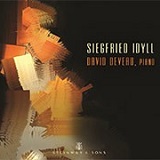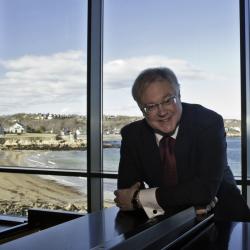Parking available in MIT West Garage, 125 Vassar St. $5 with credit or debit card.
Deveau's all-Schubert program will include: Sonata in A major, D.959 and Sonata in B-flat major, D. 960.
Program Note
Franz Schubert (1797-1828) was born and lived all of his very brief life in Vienna. He belongs to the generation following Beethoven (1770-1827), and indeed spent much of his career in the shadow of the older composer. But Schubert’s own particular genius won him many admirers who heard in his music a new, singular, and lyrical voice. He utilized many of the same structures as Beethoven in his instrumental music, but with a quite different affect and result. In his lifetime, he was most admired and renowned for his over 600 lieder (songs for solo singer and piano), often setting poetry by major poets of the time to exquisite music. He was to have been a schoolteacher (per order of his father), but his musical gift was so protean and undeniable that the young Schubert followed his passion and composed close to one thousand works, working day and night as if he knew his time on earth would be limited. Always short of money and a regular income, he relied heavily on the goodwill of his many friends to make ends meet. When one thinks of the “suffering artist toiling in his garret,” Schubert could be the poster-child for this image. Many of his works (including the two monumental sonatas heard today) weren’t published during his lifetime. Robert Schumann is owed a great debt of gratitude for discovering a number of Schubert’s late and significant manuscripts and seeing to it they were published. The two sonatas D. 959 and 960 weren’t published until 1838, ten years after Schubert’s death. These, along with such masterpieces as the two-cello quintet, the 8th and 9th symphonies, the Schwanengesang (Swan Song), were composed within months of his untimely death at 31 (probably from syphilis), and were all published posthumously. It is a great irony that all of these works have gone on to enjoy thousands of performances in concert halls, homes and on recordings worldwide, and yet Schubert never earned a pfennig from most of them.
Franz Schubert’s later works in large forms have often been described as being “of heavenly length”; so a program featuring just his two final sonatas is by no means a meager affair, with each piece clocking in at about three-quarters of an hour. These two epic sonatas share a great many characteristics: each is in an identical four movement design, with a large sonata-form first movement in a major key – complete with exposition repeats- followed by a slow movement in minor, in a simple ABA format. The third movement of each is the shortest of the four movements, in scherzo/trio form providing a light and airy respite from the pathos of the slow movement and the ensuing lengthy final movements. And yet there are differences. The A major sonata is ultimately a more dramatic and emotionally visceral piece (note the heroic opening of the first movement, and the simple sorrow of the Andantino in F-sharp minor - which is interrupted midstream by one of the most unexpected, dramatic and storm-like episodes in all music. Contrast this slow movement with the infinitely inward and tragic one of the B-flat. There, the tragedy of the outer sections is offset by a middle section that offers a glimmer of sunshine, of hope, only to return to the gloaming in the final section. The B-flat sonata’s first movement begins with a most serene and song-like melody, but is punctuated by quiet rumblings of foreboding in the form of pianissimo trills on the lowest G-flat on the keyboard. Only in the first ending of this movement’s exposition (virtually never played) does the low trill appear fortissimo, in a Beethovenian outburst against fate. One can rather easily assume an autobiographical impulse as Schubert knew at this point he was close to death, and wrote to a close friend about his infirmities and fevers, and that “no one is more miserable than I.” That fortissimo trill seems to express the composer’s anger, sadness and frustration in one violent, musical gesture.) Each sonata’s final movement is in rondo form (more or less), and each is of vividly contrasting moods within. The finale of the A major opens with a beautiful melody that is played in the right hand with chordal undulations below, and then in the left hand with graceful figurations above in the right. The movement progresses through similarly dramatic terrain as the first and second movements, but ultimately concludes with a retrograde reference to the very opening theme of the first movement, heard almost 48 minutes earlier. It is a most inspired stroke with which to conclude this mountain of a piece. The finale of the B-flat opens not with a gentle song in the tonic, but with a startling G octave marked fp that is later repeated many times during the course of the movement. This G – and what immediately follows- seems to signal the key of C minor, but after a few phrases, Schubert quickly modulates to the tonic of B-flat major. Several intervening and contrasting episodes follow, but that startling G and its quirky following material keep returning. Both this and the A major sonata have presto codas that seem to take joy in virtuosity, optimism, and life itself.
by David Deveau
Boston Musical Intelligencer feature on Deveau
About David Deveau
MIT Senior Lecturer in Music and Artistic Director of Rockport Music, pianist David Deveau has been acclaimed internationally for his expressive and poetic interpretations of repertoire ranging from Haydn to the present. He has earned enthusiastic praise from major publications, including The New York Times, The Boston Globe, San Francisco Chronicle, Pittsburgh Post-Gazette, Minneapolis Tribune, San Diego Union-Tribune, Washington Post, American Record Guide, Le Figaro (Paris) and China Daily (Beijing). Mr. Deveau’s orchestral engagements over the last three decades include solo performances with the Boston Symphony, San Francisco Symphony, Minnesota Orchestra, Pittsburgh and Houston symphonies, the St. Louis and Miami symphonies, and many others. Locally, he has appeared on many occasions as soloist with the Boston Pops, the Handel and Haydn Society, Pro Arte Chamber Orchestra and the Boston Philharmonic. In New York he has performed at Carnegie Hall, Lincoln Center, Merkin Concert Hall and the Metropolitan Museum. He has also appeared in recital at the Kennedy Center and Dumbarton Oaks in Washington, D.C., San Francisco’s Herbst Theater, Seattle’s Benaroya Hall, Pittsburgh’s Heinz Hall and on myriad other series throughout the United States and Canada.
Mr. Deveau has performed with members of the Juilliard, Shanghai, Jupiter, Cleveland, Borromeo, Muir, Ying, Kronos, Brentano and St. Lawrence string quartets, and has been a guest artist with the Boston Chamber Music Society, most recently performing in the 2009 and 2012 seasons. Festival engagements include Tanglewood, Caramoor, Wolf Trap, Mainly Mozart, Seattle Chamber Music Festival, Strings Festival (Colorado), the Montana Music Festival and the Olympic Festival, among many others.
On June 9, 2010, David Deveau, along with violinist Bayla Keyes and cellist Michael Reynolds, performed the world premiere of Scott Wheeler’s piano trio Granite Coast in the inaugural concert of the Shalin Liu Performance Center, receiving rave reviews from The New York Times and other national and local press. In September 2010 Deveau made his second concert tour of China, this time with appearances in Shanghai, following his debut tour in 2006 with concerts in Beijing and Qingdao. In November 2012 he made his first tour of Taiwan, with performances and masterclasses in Taipei and Tainan, where he also lectured at the Tainan National University for the Arts at the school’s annual International Music Symposium.
A music faculty member at MIT since 1988, Mr. Deveau has given masterclasses in piano and chamber music at Harvard, Dartmouth, the San Francisco Conservatory, Boston University, New England Conservatory and Longy School of Music. A graduate of New England Conservatory and The Juilliard School, his principal teacher was Russell Sherman; other mentors were Beveridge Webster, Veronica Jochum and Gaby Casadesus. Mr. Deveau is heard internationally on PRI, as well as on the BBC, CBC, NPR, CCTV, and on commercially available recordings on Albany, Centaur and EcoClassics.
“Altogether, this recital was, in short, one of those musical events that linger long in the memory – not for grandeur of effect and not for dazzlement, but for lyric expression that goes straight to the heart of the matter.” The New York Times

NEW CD RELEASE: David released his newest CD Siegfried Idyll on the Steinway Classics label September 2015 to critical acclaim. It was reviewed by Gramophone and the American Record Guide, and was a CD of the year pick by Jeremy Eichler in the Boston Globe. Hear excerpts from the CD in our Music Library. The New York Times CD review hailed that, “…the pianist David Deveau gives a sensitive account of a fascinating solo piano transcription of Wagner’s “Siegfried Idyll…” Read the full review



